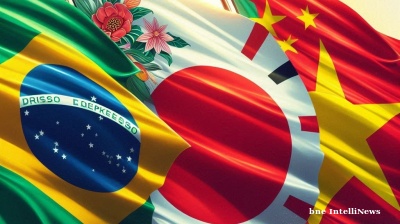US Defence Secretary Hegseth downgrades Russian threat, focus exclusively on Taiwan in new foreign policy strategy

Defence Secretary Pete Hegseth has reoriented the US military to prioritise deterring China’s seizure of Taiwan and shoring up homeland defence, but has downgraded Russia to a second tier, along with several other potential enemies.
Hegseth’s re-ranking of threats to the US is a reversal of that by his predecessor, former US Secretary of State Antony Blinken. After Blinken took over the job he named Russia as America’s “number one threat” but merely called China a leading “commercial rival” in a speech in March 2021, which then became the Biden adminstration’s 2022 National Defence Strategy.
Some have argued that the US was so reticent to concede to Russia’s demand that Ukraine never join Nato precisely in order to provoke the Russian invasion and use Ukraine as a proxy to degrade Russia’s military and economic power. Even it this was not a plan, the result of the conflict has produced exactly that result. Senator Lindsay Graham has repeated said: “This is the cheapest war America has ever fought and not one US life has been lost.”
The Kremlin also downgraded its relations with the West in an update of its foreign policy concept published in 2023 that removed all the “partnership” language when talking about Western powers and refocused its energy on developing diplomatic and economic ties with the Eurasian countries, in cooperation with China.
China is currently creating its fifteenth five-year plan that is expected to continue its Belt and Road Initiative (BRI) development and for Beijing to continue its push for greater influence in international institutions such as the UN, WTO and WHO, while promoting alternative forums like the Shanghai Cooperation Organisation and BRICS in alliance with Russia and the other global emerging market leaders, as detailed in a bne IntelliNews feature on the new transactional multipolar world model.
While Chinese President Xi Jinping has described a “no-limits” relationship with Russia, Beijing has sought to maintain at least cordial relations with Washington, despite threats and hectoring by US visiting officials. China is keen to avoid a trade war with the US, Xi has said, but is ready for a no-holds-barred fight should one begin.
Interim National Defence Strategic Guidance
Hegseth’s memo, known as the “Interim National Defence Strategic Guidance”, was distributed in mid-March, the Wall Street Journal reports, and outlines the broad brush strokes of US President Donald Trump’s foreign policy going forward. It outlines a vision to “prepare for and win a potential war against Beijing and defend the United States from threats in the “near abroad,” including Greenland and the Panama Canal,” the Wall Street Journal says, echoing the Russian term for the countries of the Former Soviet Union (FSU) that are also known as the “near abroad.” Specifically, the interim national defence strategic focuses heavily on a preparation for a potential invasion of Taiwan by China that will require reorienting the vast US military architecture toward the Indo-Pacific region.
The risks in Europe are downplayed and the strategy assumes the burden of dealing with those risk will be mostly borne by the Europeans. Likewise, threats in the Middle East and Asia dwill be borne by allies there.
“China is the Department’s sole pacing threat, and denial of a Chinese fait accompli seizure of Taiwan – while simultaneously defending the US homeland is the Department’s sole pacing scenario,” Hegseth wrote, as cited by the Wall Street Journal.
The Hegseth interim guidance also says Nato must take on “far greater” burden sharing because the US will be reluctant to provide forces with “its priorities focused elsewhere.” In effect, the document says that the US will withdraw its presence from most of the world and close the security umbrella it has provided since the end of WWII, with the exception of Taiwan.
Hegseth’s interim guidance is nine pages long, but the Wall Street Journal reports that several passages throughout are very similar to a longer 2024 report by the conservative Heritage Foundation think-tank and associated with the Heritage’s controversial “Project 2025” plan.
In parallel, a "Mar-a-Lago Accord" is being discussed, inspired by the 1985 Plaza Accord, a coordinated effort among major economies to devalue the dollar, that refers to a proposed economic strategy aiming to reset global trade and finance dynamics. Spearheaded by Vice-President JD Vance, Treasury Secretary Scott Bessent and Stephen Miran of the Council of Economic Advisers, the plan has a number of goals including:
- A strategic devaluation of the strong dollar to improve the balance of payments and enhance the competitiveness of American exports while reducing the trade deficit;
- Debt restructuring by encouraging foreign creditors to exchange existing US Treasury holdings for ultra-long-term bonds, and so easing the nation's debt burden; and
- Tariff adjustments to protect domestic industries and compel trading partners to engage in fairer trade practices.
News

Mexican authorities seize record fuel shipment in “Anti-Huachicol” operation
A recent confiscation of millions of litres of illicit fuel in Mexico has sparked discussions about the country's ongoing battle against fuel smuggling, widely known as "huachicol."

Russia offers to mediate US-Iran dialogue on nuclear programme
Russia has expressed willingness to facilitate constructive dialogue between the United States and Iran regarding the latter's nuclear programme
_1743523544.jpg)
Nearly 1,500 migrants deported from US, Venezuela confirms
Venezuela's government has confirmed the return of nearly 1,500 Venezuelan migrants deported from the United States, following the arrival of a flight carrying 175 deportees.

COMMENT: Lukashenko’s reshuffle tightens Belarus’ economic control
Belarusian leader Alexander Lukashenko has dismissed his prime minister and the head of the central bank, marking the latest stage in a year-long overhaul of the country’s leadership



_1743377740.jpg)